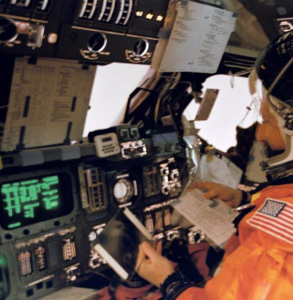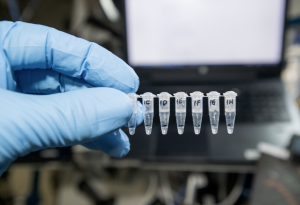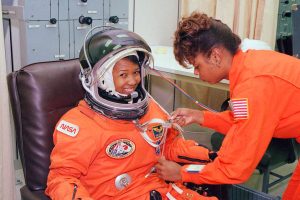7 NASA Training
After NASA called her to ask her to join the program in 1987, she had to go to Texas for interviews. The interviews included a background check and physical and mental medical exams/tests to be sure she was healthy enough to be an astronaut. The doctors found a problem with her heart called a heart murmur. That means there is a tiny hole in the heart that makes a whooshing sound. Some heart murmurs are very serious and some are not. For Mae, her heart murmur was not serious and she could continue her training to become an astronaut. After the medical tests and interviews she returned to California to wait. In June, NASA chose Mae and 15 other applicants to be astronaut candidates. Mae was the first African American woman3.
Not all candidates become astronauts, however. They needed to train for one year. After one year, NASA decides if they will continue. If they continue, they will train for another 5 years and then possibly be selected to go to space.
Mae’s training was intense and demanding. It was also exciting and challenging. She had to learn many important things to prepare for her possible journey into space. Here is a list of some of the tasks and training she went through:
- Learning About Spacecraft: Mae had to study and understand the spacecraft she would fly inside. She learned about the different controls, buttons, and systems. It was like learning to drive a very special and complex car. She had to fly a jet plane for four or more hours every month.
- Spacewalk Practice: Astronauts sometimes need to go outside the spacecraft to do important tasks in space. Mae practiced this by going underwater in a big pool wearing a special suit. The suits were similar to the suits astronauts wear in space. This helped her learn how to move in space without floating away.
- Science Experiments: In space, astronauts do lots of science experiments. Mae had to learn how to conduct experiments in a weightless environment. She practiced with different types of equipment to make sure she could do them correctly in space.

Astronauts Learning about the Shuttle Controls. 
Astronaut Edwin E. Aldrin Jr., Pilot for the Gemini-12 Spaceflight, does Underwater Zero-Gravity Training. 
Astronaut Doing a Science Experiment. - Physical Fitness: Space travel can be tough on the body, so astronauts need to be in great shape. Mae had to exercise regularly to stay strong and healthy. She learned how to use special exercise machines designed for space.
- Survival Skills: In case something went wrong during the mission, Mae and her fellow astronauts had to learn how to survive in different situations. They practiced escaping from a spacecraft in water and surviving in the wilderness. She also learned scuba diving and parachute jumping.
- Learning About the Stars and Planets: Understanding the stars and planets was crucial for an astronaut. Mae studied astronomy to help her navigate in space and recognize important celestial objects.
- Working as a Team: Astronauts work closely with their team members. So, Mae had to practice teamwork. She learned to communicate well and support one another during their missions.
- Science Classes: Mae took science classes in geology, mathematics, physics, meteorology, oceanography and other subjects3.
There were three positions an astronaut can join on a space crew: commander/pilot, mission specialist, or pay-load specialist. The commander/pilot is in control of the space shuttle and responsible for everyone on board. The mission specialist does experiments and spacewalks. The pay-load specialist doesn’t have to be an astronaut. They can do special jobs on flights or be a citizen from another country. All of the positions require similar training, but the commander/pilot has to have at least one thousand hours flying jet planes. Mae was interested and trained to be a mission specialist because she loved science and wanted to do experiments in space3.
Mae finished her 6 years of training at the Johnson Space Center in 1988. She graduated as a mission specialist astronaut and could be selected for a space mission3.
 |
 |
 |
viaje
رحلة
voyage
путешествие
ដំណើរ
hành trình
旅程
여행
complejo
معقد
complexe
сложный
ស្មុគស្មាញ
phức tạp
复杂
복잡한
flotando lejos
يطفو بعيداً
flottant au loin
уплывающий
រស់ស្រាយឆ្ងាយ
trôi đi
飘走
떠내려가는
entorno sin peso
بيئة منعدمة الجاذبية
environnement en apesanteur
невесомая среда
បរិយាកាសគ្មានទម្ងន់
môi trường không trọng lượng
失重环境
무중력 환경
escapando
هروب
évasion
побег
ការរត់គេច
trốn thoát
逃脱
탈출
objetos celestiales
الأجسام السماوية
objets célestes
небесные объекты
វត្ថុនៅលើមេឃ
vật thể thiên văn
天体
천체
